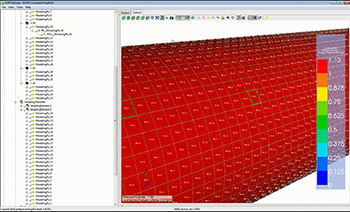Latest News
December 4, 2001
By Anthony J. Lockwood
Dear Desktop Engineering Reader:
 |
Composite materials are their own world. You have reams of layered materials ranging from concrete to ceramics and from engineered wood to metal matrices to fiber-reinforced polymers. Each constituent material in a given composite comes with its own set of chemical and physical properties, and each intended use for a composite offers its own set of stresses. All this and more makes modeling layered composite structures a difficult, albeit crucial, step in any product development regimen.
But not all composite structures pose equal simulation challenges. Some are thornier. Consequently, different modeling techniques and tools need to be employed depending upon your structure of interest and the environment in which it finds itself. For example, when you model a thin structure such as the hollow tube for a bike, you can use shell elements and achieve data for accurate predictions of the composite’s suitability for its intended use.
Shell elements, however, are not going to do you right if you’re trying to model a thick structure such as a pressure vessel for some oil and gas application. Here you need to work with solid models because the stresses in the direction of the thickness and shear stresses out of plane are substantial. Solids are also the way to go when your structure will be subject to large deformations. So, how do you go about analyzing solid models of thick composite structures like these?
ANSYS has created its “Structural Technology Tips—Composites” webpage that looks at the challenges, tools, and techniques for simulating thick composite structures. Here’s a quick tour.
The first thing you’ll notice right after you hit the Check It Out link is a video box in the center of the webpage. This is where you should start (no registration). The video itself is a short, almost 3-minute affair. The action is fast, so just watch and soak it in for your first sitting. Hint: Hit full-screen mode so that you can really see what’s going on.
What this video does is run through the process of modeling a pressure vessel—stresses, mesh, and failure criteria—with the ANSYS Composite PrepPost toolset for composite analyses. It quickly shows you the specific tools and capabilities you’d leverage to carry out this modeling job. It begins with CAD simplification and touches on defining the plies, materials, fabrics, thicknesses, and so forth. It looks at the stresses in the full models and in sections, and then it runs through your options for reviewing results.
This video is actually a teaser for a 10-minute demo called “Simulation of 3D Composites” that you’ll find linked over on the right side of the webpage. Registration is required for this demo, but it is worth it. This demo stars the same pressure vessel as in the short one and runs through the same analysis sequence. But here the process, the tools, and the techniques are presented and explained in a more leisurely and more in-depth fashion. You can take notes.
You’ll also find some good reading on the ANSYS “Structural Technology Tips—Composites” webpage. First, there’s an eminently readable, 8-page white paper called “Simulating Composite Structures” (registration required.) It provides the 50,000-ft. overview of composite modeling from the “simple,” if there is such a thing, to the complex. It’s a good place to start if you are less than knowledgeable about composites. Then there’s an article from the ANSYS user publication, “Designing Solid Composites.” It complements the two videos, and can minimize the number of notes you’ll need to take. Links to other composites data, say in wind turbine analysis, are also provided.
The upshot of all of this is that the ANSYS “Structural Technology Tips—Composites” webpage is an exceptionally informative resource. Hit the link over there and check it out for yourself.
Thanks, Pal. – Lockwood
Anthony J. Lockwood
Editor at Large, Desktop Engineering
Subscribe to our FREE magazine, FREE email newsletters or both!
Latest News
About the Author
Anthony J. Lockwood is Digital Engineering’s founding editor. He is now retired. Contact him via [email protected].
Follow DE





